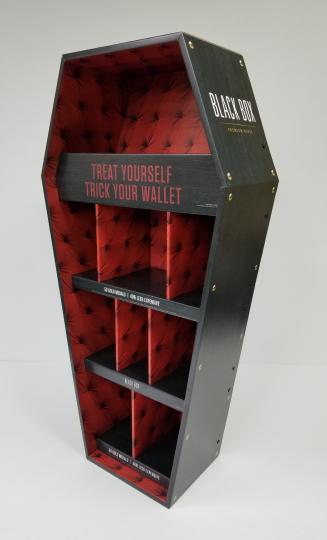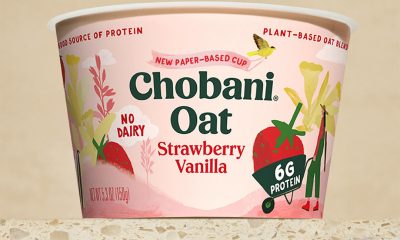Paperboard
How Do Marketers Balance Cost, Speed to Market and Sustainability in Point-of-Purchase Displays?
There are a lot of factors to balance, to say the least.
Published
5 years agoon
By
BXP ReaderWHEN IT COMES to designing and managing in-store retail merchandising through point of purchase (POP) displays, there is a lot to consider beyond fancy graphics and on-brand messaging. Retailers have to address multiple factors including how a display impacts the consumer buying process, how easy a display is to set up in store by employees, how much product can be stocked in a single display, and how large the display footprint should be, just to name a few. Marketers have been addressing these issues since the beginning of product displays, but the increasingly instant economy has mounted added pressure on marketers to not only create displays that drive revenue, but also come in on budget within a tight go-to-market timeline. Oh, and the display must also be eco-friendly. It’s a lot to balance to say the least.
If you are struggling to balance the magic triangle of controlling costs, increasing speed to market and increasing sustainability, you are not alone. While every marketing campaign is unique, there are a few best practices that can help you make the most of your POP displays.
This article is a guide to help you answer the following questions:
- What materials or design options are available for POP displays that reduce costs without sacrificing brand integrity or design?
- How can I reduce speed to market for printing and shipping product displays?
- How can the production and use of point of purchase displays be more sustainable?

The boxed wine point of purchase display was created using lightweight, inexpensive, recyclable corrugated material capable of holding 100 pounds of wine for approximately 50 percent of the cost of a wood display.
1) What materials or design options are available for POP displays that reduce costs without sacrificing brand integrity or design?
Cost is often the biggest factor that dictates the design of POP displays. How many over-the-top creative ideas have never come to fruition in the name of staying on budget? As a marketer, one of the most frustrating parts of brainstorming a campaign is to come up with a show-stopping, revenue-driving, out-of-the-box idea only to find that the campaign cannot be executed on budget. However, before you let your idea die on the budget chopping block, do some research to see what modifications can be made to maintain the integrity of your idea without going over budget. Advancements in printing technologies and display materials mean you can often use less expensive materials without sacrificing brand integrity or design.
One example is a global wine producer that sought to create a life-sized wine barrel in-store display, but had given up on the idea because it was assumed the display would need to be made out of wood to support such a heavy product. While wood is an excellent material for displays for heavy merchandise, it can be expensive to produce and ship for displays with short-term use. Instead of using wood, an alternative design was created using lightweight, inexpensive, recyclable corrugated material capable of holding 66 bottles of wine weighing 220 pounds for approximately 50% of the cost of a wood display. The display was recognized by Corrugated Today as a best example of next-gen corrugated displays. That just goes to show you that it doesn’t hurt to explore your options to see what other materials might be available to help you reach your POP display goals. Opting for a less expensive materials such as corrugated cardboard instead of wood may also leave room in the budget for additional design elements, such as motion detectors, lights, sound, coatings, scent, video and augmented reality features that can boost sales.
Advertisement2) I have a promotional campaign coming up fast. How can I reduce speed to market for printing and shipping product displays?
Today’s instant economy means fast changes take place in marketing campaigns and promotions. Even the most bureaucratic, global retailers have had to learn how to be more nimble to respond to market changes and opportunities quickly. This means marketers may be responsible for designing and producing in-store displays in record time. Speed to market is more important than ever. If you want to shorten time to market, consider the following best practices.
- Create displays that have interchangeable graphics. This means you do not have to recreate the entire display, saving both time and money.
- Instead of altering an existing display, create an attachment that communicates a new promotion or new product.
- Another best practices is to have an understanding of printing technology. Outdated software and machines can add unnecessary lag time to projects.
- Make sure your proofs are creating using 4D rendering software so edits and changes can be made quickly via digital proofs before physical mockups are created
- Eliminate the need for time consuming reprints by leveraging ready register control technology that makes corrections on the spot instead of after a project has been printed.
Look for technology that allows batches of displays to be made ready while other batches are still running, which can carve off a significant amount of production time during tight deadlines.
3) Sustainability is a core value for my brand. How can the production and use of point of purchase displays be more sustainable?
Consumers consciousness demands that brands become more responsible with the production and disposal of signage, packaging and product displays. Frankly, it often makes financial sense as well for brands to decrease waste and minimize shipping requirements. Below are a few additional strategies that can help marketers increase the sustainability and reuse of point of purchase displays.
- Start with sustainability in mind. Select eco-friendly inks and substrates from the start and design your display around the material’s specific features.
- Create a permanent fixture that can be updated with graphic inserts without disposing of the entire display.
- Ensure that there is an easy process in place to encourage employees to recycle temporary product displays.
- Design a universal display that works with all of your brand’s products instead of creating individual displays that only fit specific products.
In a digital world, POP displays have risen as one of the only tangible interactions consumers have with a brand. As such, marketers are justified in taking extra strides to ensure that the impact of POP displays is not negatively affected by budget constraints, time restrictions or compromised sustainability standards.
Paul Terry is the display division manager at Peachtree Packaging.
SPONSORED VIDEO
Branding with Ferocity – Thinking Like an Indie Brand
Get a better understanding on how to leverage new technologies to engage and delight shoppers, sustainability’s role in product and package design – being sustainable and premium are not mutually exclusive, plus best practices and tips for collaboration and how to launch new products and refresh existing product line-ups and brands.
You may like
Advertisement

GO MINIMALISM . . . HOLD ON A MINUTE!
Sustainable, 100% Recycled Transparent Sheeting is Now a Reality!

Kroger, Walgreens to Dedicate Section of Their Stores to Reusable Packaging

6 Marketing Tips for Ecommerce Brands to Win the Holiday Shopping Season

New Wunderoots Branding Celebrates the Carrot

Fact or Fiction? The Truth about Eco-Friendly Packaging

BXP May 2021 Think & Clink

Unilever Raises Bar for Accessibility with Degree Inclusive

Crown Royal’s Limited-Edition Pack Designed by Oscar-Winner

Coca-Cola Explores World of Paper Bottles
Subscribe

BULLETINS
Get the most important news and business
ideas from BXP Magazine's news bulletin.
Latest Tweets
Advertisement








